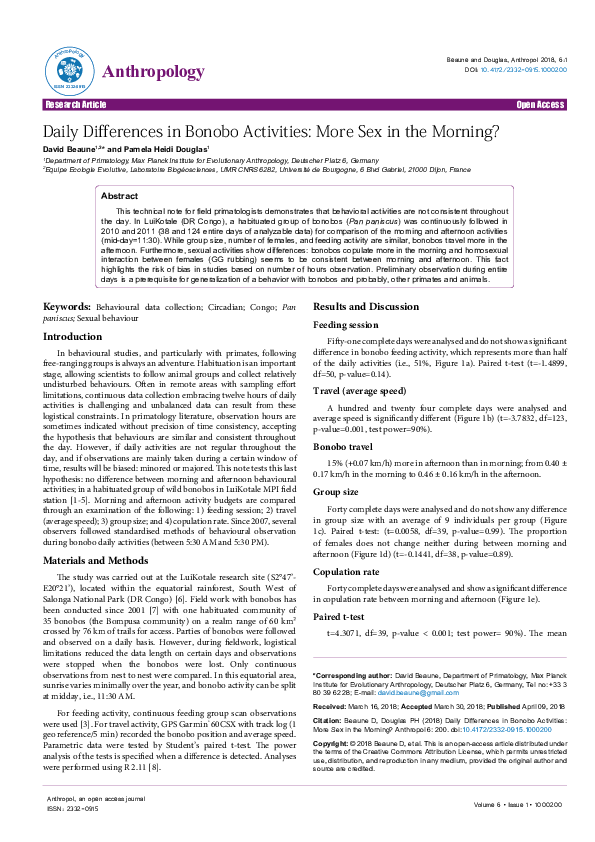Academia.edu no longer supports Internet Explorer.
To browse Academia.edu and the wider internet faster and more securely, please take a few seconds to upgrade your browser.
Daily Differences in Bonobo Activities: More Sex in the Morning?
Related Papers
2000 •
2004 •
We examined sex differences in copulation attempts in a group of wild bonobos at Wamba, Congo, by analyzing the behavioral sequence. Most copulation attempts were initiated by approach or courtship behaviors by males. Males showed these behaviors when they were more than 5 m from females, whereas females did so only when males solicited them from within 5 m. Most copulations involved females showing perineal swelling, because males solicited those females more frequently and those females accepted copulation more frequently than did females in the non-swelling phase. Nevertheless, males solicited females in the non-swelling phase in one-third of copulation attempts, and those females accepted copulation in half of those attempts. This is markedly different from chimpanzees, in which sexual behaviors almost exclusively involve females in the swelling phase. The perineum of female bonobos during the non-swelling phase is soft and wrinkled but fairly large, which may attract males to some extent. The low, but existing, attractiveness and receptivity of female bonobos during the non-swelling phase might have evolved to control sexual competition among males and provide higher social status for females.
Scientific Reports
Communication during sex among female bonobos: effects of dominance, solicitation and audience2012 •
International Journal of Primatology
Nonconceptive Sexual Behavior in Bonobos and Capuchins1997 •
Sexual behavior by infecundable females, and by same-sex and adult-immature dyads, occurs in wild and captive bonobos (Pan paniscus). Proposed functions of these behaviors, in social primates generally, include practice, paternity confusion, exchange, and communication as well as appeasement. We used this framework to interpret and to compare observations of sexual behavior in a captive bonobo group and a wild white-faced capuchin (Cebus capucinus) group. In both species, (a) sexual behavior was no more frequent in cycling females than in pregnant or lactating females and (b) same-sex and adult-immature dyads engaged in as much mounting or genitogenital contact as adult heterosexual dyads did. The species differed in that (a) bonobos engaged in sexual behavior 65 times as frequently as capuchins, (b) only bonobos engaged in sexual contact other than ventrodorsal mounting during focal observation, and (c) bonobo sexual contact was concentrated most heavily in socially tense situations in adult female–female dyads, whereas capuchin sexual contact was concentrated most heavily in socially tense situations in adult male–male dyads. These data and published literature indicate that (a) practice sex occurs in both species, (b) paternity confusion may be a current function of C. capucinus nonconceptive sex, (c) exchange sex remains undemonstrated in capuchins, and (d) communication sex is more important to members of the transferring sex—female bonobos and male capuchins—than to members of the philopatric sex.
Scientific Reports
Sex and grooming as exchange commodities in female bonobos’ daily biological marketThe Biological Market Theory (BMT) posits that cooperation between non-human animals can be seen as a mutually beneficial exchange of commodities similarly to what observed in human economic markets. Positive social interactions are commodities in non-human animals, and mutual exchanges fulfilling the criteria of the BMT have been shown in several species. However, the study of biological markets suffers from methodological limitations that are mainly linked to the difficulty of clearly identifying the currencies and their exchanges in the short-term. Here, we test whether bonobo females are more attractive during their maximum swelling phase, whether they exchange grooming and Genito-Genital Rubbing (GGR) on a daily level of analysis, and whether these daily exchanges fulfil the BMT criteria. Females engaged more in GGR when their sexual swelling was in the maximum phase. Moreover, they exchanged grooming and sex according to the daily “market fluctuations” associated with swelling...
2006 •
We compared sex differences in behaviors leading to copulation of chimpanzees (Pan troglodytes) in the Kalinzu Forest, Uganda with those of bonobos (Pan paniscus) at Wamba, D.R. Congo, using the same definition. Female chimpanzees were more likely to initiate copulation than female bonobos. While most of copulations (96%) were initiated by males in bonobos, among chimpanzees only 63% of copulations were initiated by males. Female bonobos initiated an interaction leading to copulation when males approached them within a short distance. On the other hand, both male and female chimpanzees initiated behavior at a longer distance. Higher proceptivity and a higher copulation rate during the maximal swelling period of female chimpanzees might suggest that they gain greater benefits from a high frequency of copulations than do female bonobos.
International Journal of Primatology
Increased Frequency of Intergroup Encounters in Wild Bonobos (Pan paniscus) Around the Yearly Peak in Fruit Abundance at Wamba2018 •
RELATED PAPERS
THE SCYTHIAN ARCHAIC GRAVE IN THE TRACT MARCHENKI NEAR BILSK HILLFORT
THE SCYTHIAN ARCHAIC GRAVE IN THE TRACT MARCHENKI NEAR BILSK HILLFORT2020 •
2024 •
Latin America Research Commons eBooks
Democracy Versus Democracy: The Populist Challenge to Liberal Democracy2022 •
2007 •
2011 •
Journal of Cutaneous Pathology
The Dermal Component in Melanosis Naeviformis Becker1979 •
International Polymer Processing
Viscoelastic and Electrical Properties of Carbon Nanotubes Filled Poly(butylene succinate)2014 •
Physical Review Letters
Quantum Phase Transitions in Mesoscopic Systems2004 •
2007 •

 David Beaune
David Beaune